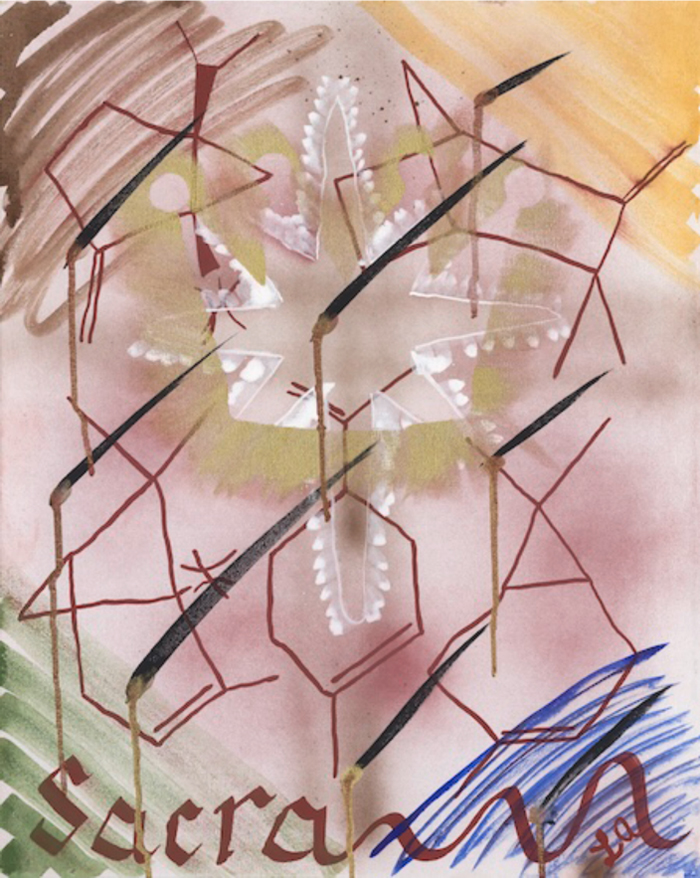
Frankincense (Boswellia sacra) by Lucas Anderson
Buy Prints Online
Paper prints and canvas prints of this painting of various sizes are available through Lucas Anderson’s website.
About the Painting
Each painting in the series is created on canvas using hand-mixed egg tempera, made with carefully selected pigments. A “primary” colour is chosen for each piece—used to depict the chemical structure—and infused with a small amount of the corresponding essential oil to capture its unique energetic quality.
Support Conservation
To support the sustainability of the Boswellia species supply chain, Essential Oil Art will donate 50% of the profits from the sale of prints featuring the nine species of frankincense paintings to Airmid.
This donation serves as a gesture of gratitude to Airmid for covering the cost of supplies for these artworks, reinforcing our shared commitment to the preservation and ethical sourcing of frankincense.
Prime Colour
Red Ochre
Artist’s Statement
This painting of Boswellia sacra essential oil is rich with symbolism, spirituality, and personal reflection, infused with layers of meaning tied to Christian beliefs and the story of this revered tree.
At its core, the painting reflects the belief—however unsubstantiated—that this might have been the frankincense given to baby Jesus. Created over Christmas, the artwork is steeped in themes of faith and renewal. The corners of the canvas are filled with symbolic colours to eliminate white space:
- Yellow for gold, a gift fit for royalty.
- Brown for wood, representing the cross.
- Blue for royalty, tied to Jesus as the ultimate King.
- Green for new life and resurrection, symbolic of both the tree’s resurgence and Jesus’s resurrection.
The centre of the painting features red blotches, powerfully symbolizing the blood of Christ on the cross. Overhead, a star shines brightly, representing the Star of Bethlehem that guided the Magi to Jesus. A crown is present as well, a tribute to Jesus’s royalty and His role as the ultimate King. As well as the role this species plays in the royalty of the region, the Sultan.
In the background, subtle markings of a cross are hidden, inviting viewers to discover this deeper layer of meaning.
One of the most striking elements is the inclusion of eight black slashes, each dripping with red and gold. These slashes symbolize the tapping process of Boswellia sacra trees, with the red representing the tree’s “lifeblood” and the gold its immense value. The choice of eight slashes was deliberate, reflecting the biblical significance of the number: new life and resurrection. This ties both the Messiah and the trees into a shared narrative of rebirth and renewal, underscoring the profound connection between humanity, nature, and spirituality.
This deeply personal and evocative painting weaves together faith, symbolism, and the natural beauty of the Boswellia sacra tree, offering a meditative exploration of life, sacrifice, and resurrection.
Botanical Information
Boswellia sacra, native to Oman and Yemen, is locally known as Hoojri, Najdi, Shathari, and Shaabi. It is recognized for its rich therapeutic properties, primarily attributed to its major chemical constituents, including α-pinene, myrcene, sabinene, limonene, and δ-3-carene. Additionally, some B. sacra populations exhibit an E-β-ocimene/limonene chemotype. These compounds contribute to its antimicrobial, anti-inflammatory, analgesic, chondroprotective, antibronchitic, gastroprotective, anxiolytic, vulnerary, anti-acetylcholinesterase, and mucolytic properties.
The essential oil of B. sacra resin has a distinctive fragrance profile described as rich, fresh, sweet-resinous, slightly woody, green-peppery, and sweet-coniferous. Unlike Boswellia rivae, B. sacra is actively tapped for its resin, with trees undergoing a regulated harvesting process to ensure resin production.
It is categorized as Near Threatened (Thulin, 1998) with ongoing re-assessment indicating potential vulnerability. The species faces threats such as overharvesting and grazing, particularly from camels, which impact regeneration rates.
Ensuring ethical sourcing and sustainable collection practices, including implementing rest periods for trees, enforcing responsible tapping techniques, and providing fair wages for local harvesters, is crucial for preserving B. sacra populations. Given its rich chemical profile, therapeutic benefits, and cultural significance, B. sacra remains a valuable species for aromatherapy, medicinal applications, and responsible trade.
Johnson, S. P., & Ablard, K. M. (2020). Frankincense: Tapping into a sustainable future. International Journal of Professional Holistic Aromatherapy, 9(3), 45-56.
Thulin, M. 1998. Boswellia sacra. The IUCN Red List of Threatened Species 1998: e.T34533A9874201.


